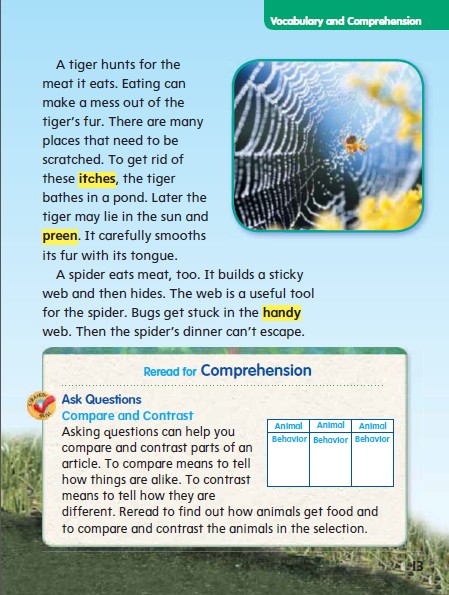在学习加州教材的过程中,会学习到课文中大量的有价值的词汇,G2-G3的课文中,30-50个新词汇是普遍的,其中含有不少具有抽象意义的词汇,我们在教学中,学生能理解的肯定用英文来解释,学生难以理解的会适当给予中文解释。
外教在这一点上是最难入手的,因为面对的是中国学生,而不是美国等外籍学生。
我们用加州Treasures教材 G2-UNIT4-THEME1 来说明这个问题,先看课文引导,关键的词汇已经黄颜色标明,正文会重复这些词汇,让孩子加深印象,在阅读中充分掌握。



 我们Lillian英语授课时解释的词汇数量要远远大于课文vocabulary规定的词汇:
我们Lillian英语授课时解释的词汇数量要远远大于课文vocabulary规定的词汇:
Beast: an animal, especially one that is large or dangerous
Puddles: small pools of water
Nibble: to take small bites of sth, especially food
Itch: to have an uncomfortable feeling on your skin that makes you want to scratch
Preen: to smooth or clean feathers with the beak or bill
Raccoon: 浣熊(抽象词汇)
Search: look for
Acorn: 橡树果(抽象词汇)
Mess: a disorderly or dirty accumulation
Escape: to get away from sth.
Spray: to cover sb/sth with very small drops of a liquid
Soak: to put sth. In liquid
Slog: to walk or travel somewhere steadily, with great difficulty
Snort: 哼着鼻子说话(抽象词汇)
Fluffing: 毛茸茸的(抽象词汇)
Straighten: to make sth. Straight
Sprinkler: a tool used to spray water
Waterproof: be unaffected by water
Spread: to extent
Soggy: wet and soft
Oxpecker: 牛椋鸟(抽象词汇)
Hippos: 河马(抽象词汇)
Algae: 海藻(抽象词汇)
Moray eel: 海鳝(抽象词汇)
Peck: to move the beak forward quickly and hit or bite sth
Tick: 虱子(抽象词汇)
Crack: to break sth. apart
Termite: 白蚁(抽象词汇).